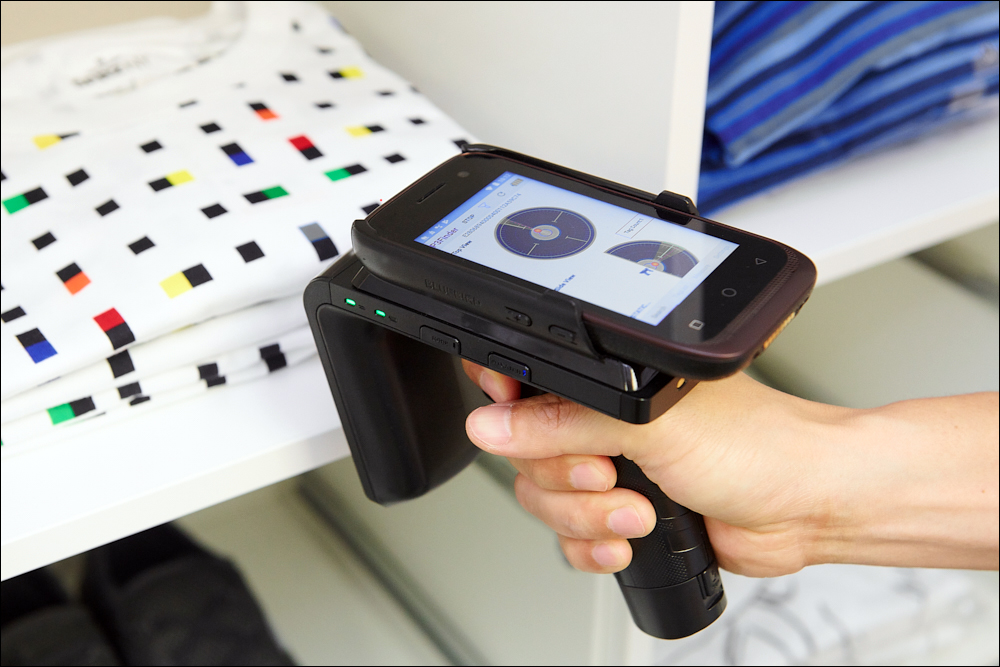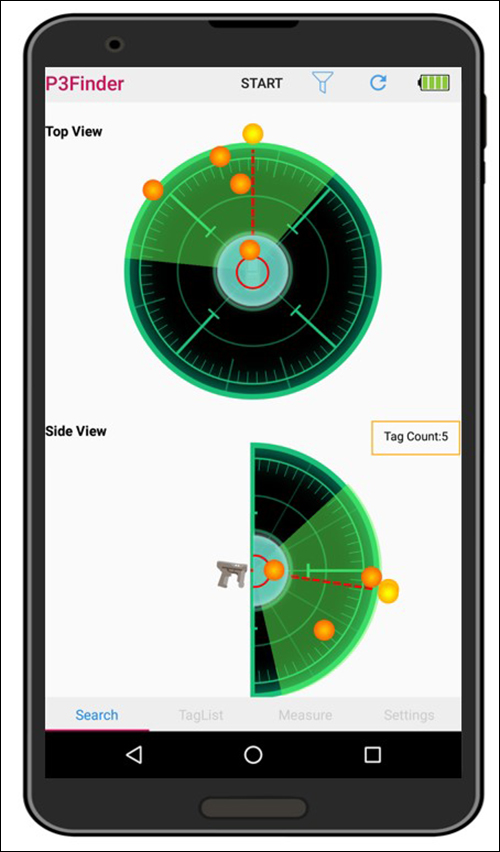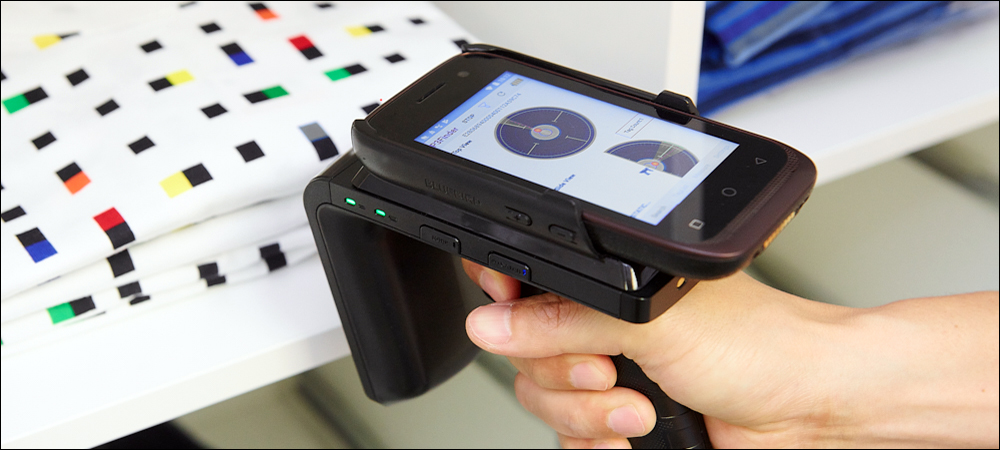- Locating Goods in DCs for Online Purchases
- The Need for High-Accuracy Location
- How the P3 Finder Works
Japanese apparel company Baroque Japan Ltd. has increased the locating speed and accuracy of its existing radio frequency identification solution with the introduction of a 3D RFID reading application from RFLocus known as P3 Finder, which brings visibility to inventory across 150 of its 700 stores. The company already has UHF RFID tags on all the merchandise it receives, stores and sells, while the P3 Finder app, used on its handheld readers and integrated with Sensormatic‘s TrueVUE Cloud software, provides access to location data at the stores and distribution center to provide merchandise to customers quickly.
With the P3 Finder radar navigation app built into the company’s RFID readers, Baroque Japan is better able to serve the demand for “buy online, pickup in store” (BOPIS) purchasing by ensuring inventory counts at each store remains accurate and up-to-date. The P3 Finder tool is designed to improve working efficiency and customer satisfaction by picking the items more quickly, according to Tomoyuki Asano, RFLocus’s CEO, and the retailer says its staff can more easily find items required for restocking in stores.

To use the P3 Finder app, employees enter the items for which they are searching into their mobile device, then swing it slowly left and right, and up and down, while moving around the targeted area.
Locating Goods in DCs for Online Purchases

The P3 Finder app
Baroque Japan, which opened its first stores in 2000, offers clothing lines such as Moussy and Sly. The company sells 21 brands from its stores throughout Japan, China, Hong Kong and the United States, and it operates wholesale businesses in 26 countries. Its Higashimatsuyama Sagawa Distribution Center is managed with the help of the company’s warehouse-management software for location management of the products, says Takushi Tokuno, the general manager of Baroque Japan’s Logistics Department. The main tasks of sorting and inspecting goods, however, are accomplished by humans, he says, so mistakes inevitably occur.
Without an automated method to capture inventory counts, such mistakes could often go unnoticed. One common error could be a discrepancy between the number of products listed in the system and the actual number of items onsite. “When inventory is counted,” Tokuno says, “items that were thought to be missing are often found onsite.” In stores, he adds, the number of products in the data did not always match the number of products on the floor or in stock, and sales opportunities were missed because products that should have been available onsite could not be located.
To solve these problems, the company sought a tool that could locate products quickly and accurately via the RFID tags on its goods. “We were already using the search function of Johnson Controls‘ RFID inventory-management system TrueVUE,” Tokuno says, “but we wanted a more accurate search tool.” (Johnson Controls is Sensormatic’s parent company.) Baroque Japan’s management approached Sagawa Global Logistics, the company that oversees its onsite logistics operations, and that company recommended the P3 Finder tool. RFLocus set up a demonstration of the application at the distribution center, and the company decided to introduce it based on workers’ satisfaction with the technology.
The Android- and iOS-based P3 Finder mobile handheld app uses 3D radar, Asano says, to display a graphical view of the object to be searched for—not only in the horizontal plane but also in the vertical direction. That means users can view not only the general location within a store or warehouse, but also the shelf level on which a specific item might be stacked. Users can thus understand, in real time, how close they are to all of the items at any given time. In addition, the view presents the relative distance between tags. “We tested the system not only in our warehouse, but also in our stores,” Tokuno states, “and even staff who did not have a good grasp of the store’s inventory were able to quickly locate the desired item.”
The Need for High-Accuracy Location
Online purchasing makes inventory accuracy in the warehouse and at stores more important than ever, the retailer reports. The Higashimatsuyama Sagawa Distribution Center is an integrated warehouse at which products sold in stores, and those sold via the Web, can all be managed. Since the inventory-management data is linked to the online system, the product can be displayed as available for customers, as long as a product is available at either the DC or the store.

Tomoyuki Asano
The distribution center contains a complex set of inventory within a large area. In the case of online products, unlike inventory at stores, products are still stocked after the sales season and remain available for sale. When a purchase is placed online, the product must then be located in the warehouse and be shipped directly to the buyer’s delivery location of choice, such as their home or a neighboring store. However, Tokuno says, products are often not where they are supposed to be in the warehouse, so “there may be a discrepancy between the data in the system and the actual situation onsite.”
Although products were already tagged with UHF RFID tags, Tokuno says, and although staff members had handheld RFID readers, products still might not always be located easily. “We had a problem,” he recalls, “in that we often had to rely on the experience, knowledge and intuition of our leadership staff to search for products.” In a busy store environment, Tokuno explains, with customers looking at, purchasing or simply moving products, locating goods has proven challenging. “Finding the desired product in the limited area of a store is actually a very labor-intensive task.”
With the P3 Finder app, the company has been able to reduce the amount of time staff members spend each day searching for missing items, or those being requested by customers. After trying out a P3 Finder demo application in 2019, the company began using it at the Higashimatsuyama DC in February 2020. It then launched a test implementation at stores in April of that year. In February 2021, the installation team integrated the P3 Finder tool and the TrueVUE software.
How the P3 Finder App Works
To use the P3 Finder app, employees enter the items for which they are searching into their mobile device, then swing it slowly left and right, and up and down, while moving around the targeted area. The reader sends interrogation signals at a rate of more than 400 times per second to determine each tag’s 3D position once that tag responds. As a tag is located, the app displays the item’s location as an orange dot on the handheld’s screen, and users can then swing the reader again to gain an exact location. When the reader is directly in front of the tagged item, an audible alert sounds.

Takushi Tokuno
At stores, staff members use the P3 Finder’s search function for multiple purposes. While counting inventory at a store or DC, employees use the app to capture the location and identification of every product as they move through an area. If there is a discrepancy between the inventory data in the management system and the actual inventory count, P3 Finder can identify that problem. The system has helped Baroque Japan’s management team judge the cause of any discrepancy discovered between the data and the number of items on hand, by displaying where a product is located, including its specific shelf, along with its history of movement. The RFID deployment will continue to expand over time, Tokuno reports.
“There is a direction within our company to further switch to RFID-based product management in the future,” Tokuno states. That could mean deploying the P3 Finder application across additional stores. Going forward, he hopes to see a collaboration between RFLocus and Johnson Controls, which he speculates could result in further features that will make inventory management more efficient. In addition to P3 Finder, he says, “There are many other technologies and services that we are interested in.” Among them is RFLocus’s Locus Mapping solution, which can display product and inventory locations on a digital map, as well as the RFID GO gate.
Locus Mapping, a cloud-based inventory-management solution, facilitates operations on tracking assets and their locations in a large warehouse. Upon walking into a warehouse setting, personnel can survey all assets using the P3 Finder app, after which the scan results will be presented in a digital display. According to Asano, RFLocus is actively expanding its deployment presence beyond the Japanese market. “We feel that P3 Finder has greatly reduced the number of cases in which we are unable to sell products because we don’t have them,” he says.
Key Takeaways:
- Japanese fashion retailer Baroque Japan is gaining more value from its RFID deployment, thanks to a precision locating tool from RFLocus.
- Since deploying the P3 Finder app at its DC and at 150 stores, the company says searches are now faster and lost sales due to inventory discrepancies are rare.


